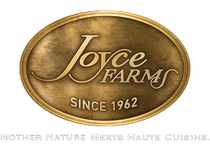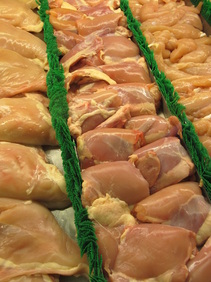
“The idea was to re-position the way we describe our highly differentiated – and great tasting – products,” he said in a recent interview, which included changing their company name (the firm’s overarching brand) as well as the names of two distinct product lines. “We presented two choices to focus groups of high income consumers who buy natural or organic meat and poultry on a regular basis. I expected a resounding approval for my favorite, Joyce Family Farms, but instead came away with a good dose of consumer cynicism. They thought Joyce Family Farms sounded like a big company trying to pretend they were a small family farm!”
Joyce Farms began as Joyce Foods in 1962, a poultry distributor selling to Mom & Pop grocery stores. Ron joined his father in 1971 and twenty-four years later began the switch to a more natural, more vertically integrated approach to producing poultry, driven by the idea that the chicken on American dinner tables didn’t have to be bland and tasteless.
“We now control the whole process,” Joyce says, “from genetic selection to breeding to placing our birds with small Southern family farmers who embrace the kind of slow growth, environmentally sustainable practices we insist upon. We never add hormones, antibiotics, animal by-products, preservatives or artificial ingredients anywhere in our process. The key to our success is total purity, especially the free and easy way in which we raise our birds, even to the point of chasing the chickens down ourselves and processing them in our own plant! All this extra effort pays huge flavor dividends, more like the chicken I remember from Sunday dinners at my grandmother’s farm – back when chicken actually tasted like chicken, instead of some pale imitation of chicken. We’ve all but forgotten that here in the 21st century.”
Joyce claims that the huge majority of today’s birds are industrial, “raised in conditions about as far removed from my grandmother’s farm as a sunny meadow is from a prison yard. Today, it’s all about price: how many chickens you can produce as quickly as possible at as low a cost as possible. In contrast, we allow our Poulet Rouge line of Heritage chickens 80 days to mature. They stay happy doing natural chicken things for almost twice as long as the stressed and unhappy birds that eventually make their way to your local grocery store.” Joyce says that investment in time (and feed costs) pays off in flavor and texture, which makes Joyce Farms chicken well worth the high price they command in the marketplace – a fact confirmed by leading chefs “who care enough about their guests’ dining experience to serve the best chicken in the world.”
 photo © by Brian E. Faulkner
photo © by Brian E. Faulkner That taste difference applies not just to the company’s well-regarded Heritage lines but to their newly re-branded line of Naked Chicken (sold to the culinary and artisanal butcher markets and to consumers through their web site) as well as a more recent addition to the Joyce Farms family, Naked Beef. Joyce says his grass-fed beef, developed from old prairie stocks and raised on small family farms, not only is more tender and succulent than ordinary grass-fed beef but rivals the best beef on the market for taste. And, like Joyce Farms chicken, Joyce Farms Naked Beef “never-ever” has artificial ingredients added to speed up the fattening process, cheapen the product and cut the price.
Ron Joyce credits Jamie Oliver, The Food Network’s Naked Chef, with popularizing the “naked” concept, which in the case of Joyce Farms reflects on “all we have not added to our product.” Even so, he was uncertain whether the focus groups would buy the Naked Chicken idea. They did – overwhelmingly and enthusiastically, and a new brand was born.
TakeAway: Build authentic and compelling brand names on your unique Marketable Truth© and then test them – without spending outrageous sums for naming consultants.
Marketable Truth © by Brian E. Faulkner.
http://joyce-farms.com/

 RSS Feed
RSS Feed